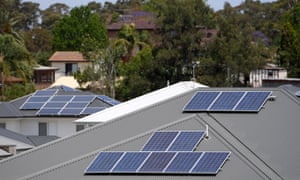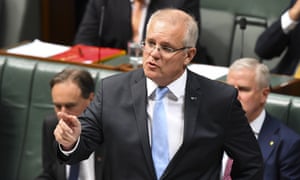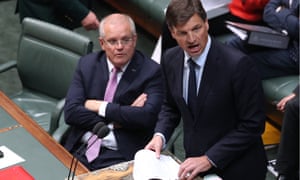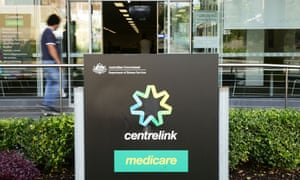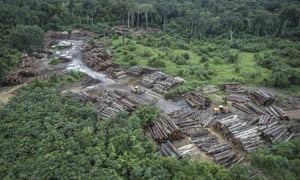The renewable boom will end without a national policy to encourage future clean investments, industry warns
Clean energy will be providing 35% of Australia’s total electricity
needs within two years, analysts say, as new data underlines the pace at
which solar power is transforming the national energy market.
A report by consultants Green Energy Markets found rooftop solar systems and new large-scale farms regularly pushed renewable energy to beyond 30% of generation at midday during June, one of the least sunny months.
Wind, hydro and solar power made up 22.3% of electricity used across the month. The level of clean energy in the system at one time peaked at 39.2% in the middle of the day on 30 June.
Tristan Edis, a Green Energy
Markets director and analyst, said clean energy growth would continue
in the short term as a number of projects were in development and yet to
come online. But he said the boom was expected to end in the absence of
a policy to encourage further investments.A report by consultants Green Energy Markets found rooftop solar systems and new large-scale farms regularly pushed renewable energy to beyond 30% of generation at midday during June, one of the least sunny months.
Wind, hydro and solar power made up 22.3% of electricity used across the month. The level of clean energy in the system at one time peaked at 39.2% in the middle of the day on 30 June.
He said he expected clean energy would provide on average 35% electricity by 2021.
“What we are seeing now is just a glimpse of what’s ahead because you’ve still got a substantial number of solar farms coming through,” Edis said. “We’re going to be regularly having 50% of renewables – solar, wind and hydro – across the national electricity market in the middle of the day in the next 12 months. But it is also soon going to get hard to get new stuff built.”
A report by the Clean Energy Regulator last week found enough projects were committed to meet the 2020 renewable energy target, roughly equivalent to 23% of electricity. While most recent investment has been driven by incentives attached to the target, and to a lesser extent a state target in Victoria, recent large-scale clean plants have been funded on a commercial basis by businesses wanting to lock in cheap solar and wind deals while wholesale electricity prices were high.
But Edis said this would end as abundant free solar power during the day reduced wholesale prices to a level where investment in any type of new large-scale generation was not financially attractive. In the absence of federal policy to drive grid transformation, he said investment was likely to slow until the circumstances in the market changed – for example, a coal-fired power plant closed, reducing supply.
“It just shows how crazy this idea is that we should go and build another coal-fired generator to run as baseload,” Edis said. “If we do that it just means another coal-fired power plant is going to shut down because nothing can outcompete solar and wind.”
Greenhouse gas emissions from electricity are expected to continue to be reduced in the short-term, but at a slower pace than experts say is possible or necessary for Australia its part under the Paris climate agreement. While federal data released last month found emissions from electricity were down, national emissions continue to rise due to increased carbon pollution from the resources industry, mostly liquefied natural gas production for export, and transport.
‘Any of them could do the job’
At an Australian clean energy summit in Sydney on Tuesday, the Clean Energy Council chief executive, Kane Thornton, said it had been a record-breaking two years, with more than $24bn worth of large-scale renewable energy projects, solar panels on 2m homes and the world’s biggest battery based in South Australia.But he said a survey of 75 chief executives showed industry confidence had fallen since December due to policy uncertainty, growing constraints on the grid and the pace at which regulations and markets that had been designed for last century were having to be changed. The survey found energy bosses believed the single greatest challenge facing the industry was getting new farms and plants connected to the grid. A lack of energy and climate policy was the second biggest challenge.
“The economics of clean energy continues to improve and we no longer require subsidy,” Thornton said. “But the wholesale market is riddled with uncertainty.”
He said collaboration on energy between the commonwealth and the states was near non-existent, noting federal and state ministers energy ministers had not met for eight months and no meeting was planned.
Thornton said a sensible energy policy could accelerate investment, drive down power prices and deliver jobs in rural areas. The industry did not mind whether the policy was the abandoned national energy guarantee, an extended renewable energy target, the clean energy target proposed by the chief scientist, Alan Finkel, or a baseline-and-credit trading scheme. “Any of them could do the job,” he said.
NSW threatens to go it alone
Matt Kean, the New South Wales energy and environment minister, repeated his warning that the Berejiklian government would introduce its own climate and energy policy if the federal government did not act.“The NSW government still supports the national energy guarantee and will continue to support a national mechanism that integrates climate and energy policy,” he told the summit. “As I’ve said before, if the commonwealth won’t get on board NSW will consider going it alone.”
Kean said NSW wanted to be known as the easiest jurisdiction in the OECD for energy construction.
Thornton said the industry was still on track for 50% clean energy before 2030 and a fully renewable energy system was now inevitable and could be achieved well before mid-century. He said the next stage would be decarbonising other sectors such as transport and building a renewable export industry selling green hydrogen and clean energy via undersea cable.
“It’s now time we started debating when Australia should target 200% renewable energy generation,” he said.
